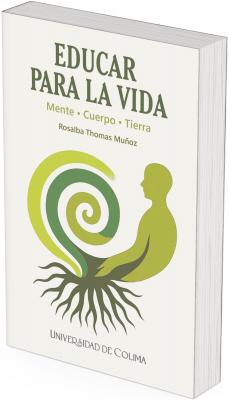Educar para la vida: Mente - Cuerpo - Tierra
Palabras clave:
Educación ambiental, enfoque holístico, naturaleza, sustentabilidadSinopsis
Educar para la vida. Mente - Cuerpo - Tierra propone una transformación educativa basada en la integración de la mente, el cuerpo y la tierra, con un enfoque holístico que promueve el bienestar individual, social y ambiental. Destaca la necesidad de reconectar con la naturaleza y los valores esenciales, adoptando la creatividad, la reflexión crítica y la resiliencia como herramientas fundamentales para enfrentar los retos actuales. Inspirado en filosofías como el zanshin y el zen, el texto enfatiza la importancia de la interdependencia entre los seres humanos y su entorno. En la primera parte, se fundamenta la necesidad de repensar la educación frente a los impactos del modelo productivo capitalista; la autora profundiza en cómo nuestras percepciones y acciones están influenciadas por la cultura, los sentidos y la interacción con el mundo natural. En la segunda parte, se presentan actividades prácticas y reflexivas diseñadas para inspirar cambios significativos en los niveles personal, comunitario y global, desde propuestas de sustentabilidad y conexión con la naturaleza, hasta dinámicas culturales y ejercicios de introspección que buscan fomentar la creatividad, el diálogo y la acción consciente. Este enfoque integral invita al público lector a convertirse en agentes de cambio, promoviendo valores y hábitos en la relación con el planeta.
Descargas
Referencias
Alcarazo y López (2011). Propuesta didáctica de una simulación: "La Central Nuclear". Revista electrónica de didáctica / español lengua extranjera (22). https://www.educacionyfp.gob.es/dam/jcr:744b2c6e-3cdb-4a28-a5fb-b5162efcf682/2011-redele-22-01alcarazo-pdf.pdf
Atlantic International University. (2025). Nutrición para la salud y el bienestar sostenible. https://www.aiu.edu/es/blog/nutricion-para-la-salud-y-el-bienestar-sostenible/
Bach, A.; Maneja, R.; Peñuelas, J. y Llusià, J. (2021). Pasear por la naturaleza reduce los niveles de cortisol, la hormona del estrés. Forests.
Bird-David, N. (1999). Animism Revisited: Personhood, Environment, and Relational Epistemology. Current Anthropology, 40(S1), S67-S91. https://doi.org/10.1086/200061
Bok, S. (1999). Lying: Moral choice in public and private life. Vintage Books. https://archive.org/details/lyingmoralchoice0000boks_h3n4.
Bourdieu, P. (1999). Meditaciones pascalianas. Anagrama.
Brown, W. (2015). El pueblo sin atributos. La secreta revolución del neoliberalismo. Malpaso ediciones.
Budokan, N. (2009). Budō: The martial ways of Japan. (Alexander Bennett, trad.). Nippon Budokan Foundation.
Calderón, S. S. y Caicedo, C. P. (2019). Educación ambiental: Aspectos relevantes de sus antecedentes y conceptos. Ingeniería y Región, 22, 14-27. https://doi.org/10.25054/22161325.2565
Calixto, R. (2012). Investigación en educación ambiental. Revista Mexicana de Investigación Educativa, 17(55), 1019-1033. http://www.scielo.org.mx/scielo.php?script=sci_arttext&pid=S1405-66662012000400002&lng=es&tlng=es
Camacho, P. C. (2014). Efectos del neoliberalismo en el sistema de educación superior en México. Cuadernos fronterizos, 31 (10).
Caride, J. A. y Meira, P. (2001). Educación ambiental y desarrollo humano. Ariel Educación.
Carson, R. (1962). Silent spring. Houghton Mifflin Harcourt
Cubero, M. y Santamaría, A. (2005). Psicología cultural: una aproximación conceptual e histórica al encuentro entre mente y cultura. Avances en Psicología Latinoamericana, 23, 15-31.
De Sousa, B. (2006). Capítulo I. La sociología de las ausencias y la sociología de las emergencias: para una ecología de saberes. En B. De Sousa, Renovar la teoría crítica y reinventar la emancipación social. CLACSO.
Deshimaru, T. (2014). Zen y artes marciales. Luis Cárcamo, Editor.
Díaz, J. (2024). Terapia somática: explorando la conexión cuerpo-mente. https://diazcaneja.com/terapia-somatica-explorando-la-conexion-cuerpo-mente/
Durkheim, E. (1893). The division of labour in society. https://www.simonandschuster.com/books/The-Division-of-Labor-in-Society/Emile-Durkheim/9781439118245.
Escritos de Psicología. (2024). La conexión entre el cuerpo y la mente para tu bienestar. https://www.escritosdepsicologia.es/el-cuerpo-y-la-mente/
Feldenkrais, M. (1997). Awareness through movement: Health exercises for personal growth. HarperOne.
Foladori, G. y Gonzalez, E. (2001). En pos de la historia en educación ambiental. Revista Tópicos en Educación Ambiental, 3 (8), 28-43. http://ricaxcan.uaz.edu.mx/jspui/handle/20.500.11845/242
Fukuoka, M. (2011). La revolución de una brizna de paja. Ediciones EcoHabitar.
Gallup. (s.f.). State of the global workplace. https://www.gallup.com/workplace/349484/state-of-the-global-workplace.aspx.
García, E. (1989). A propósito de la modernidad y de la postmodernidad. Revista de Espiritualidad, 48, 353-388. https://www.revistadeespiritualidad.com/upload/pdf/290articulo.pdf
Hanna, T. (1994). Somatics: Reawakening the Mind's Control of Movement, Flexibility, and Health. Da Capo Press.
Harrod, S. (2012). Las enseñanzas secretas de las plantas: la inteligencia del corazón en la percepción directa de la naturaleza. Inner Traditions.
Harvey, G. (2005). Animism: Respecting the living world. Routledge. https://www.routledge.com/Animism-Respecting-the-Living-World/Harvey/p/book/9780231137010
Historia del cine (2023). Blog sobre cine. https://historiadelcine.es/glosario-terminos-cinematograficos/tipos-planos-en-cine/
Hyams, J. (1979). Zen in the martial arts. J.P Tarcher, Inc.
Ingold, T. (2006). Rethinking the animate, re-animating thought. Ethnos, 71(1), 9-20. https://doi.org/10.1080/00141840600603111
Juárez-García, A. I.; Álvaro, J.; Camacho-Ávila, A. y Placencia-Reyes, O. (2014). Síndrome de burnout en población mexicana: Una revisión sistemática. Salud Mental, 37(2), 159-176. https://doi.org/10.17711/SM.0185-3325.2014.020
https://doi.org/10.17711/SM.0185-3325.2014.020
K12 Academics. (s.f.). History of environmental education. https://www.k12academics.com/education-subjects/environmental-education/history?form=MG0AV3
Kapleau, P. (2006). El despertar Zen. Editorial Pax México.
Kirmayer, L. J.; Worthman, C. M. y Kitayama, S. (2020). Culture, mind, and brain: emerging concepts, models, and applications. Cambridge University Press. https://doi.org/10.1017/9781108695374
Krmpotic, C. S. (2016). La espiritualidad como dimensión de la calidad de vida: Exploraciones conceptuales de una investigación en curso. Scripta Ethnologica, 38, 105-120. https://www.redalyc.org/pdf/148/14849184006.pdf
Mann, J. (2012). When buddhists attack: the curious relationship between zen and the martial arts. Tuttle Publishing.
Margalef, R. (1997). Dinámica de los ecosistemas: ¿hacia dónde camina el planeta? En R. Lara y M. Novo (coord.), La interpretación de la problemática ambiental: enfoques básicos. Fundación Universidad-Empresa.
Medvedeva, E. (2023). Senses help the brain interpret our world - and our own bodies. Science News Explores.
Michalik, G. (2023). Co-creation mindset: eight steps towards the future of work. Springer. https://doi.org/10.1007/978-3-031-21191-1
Michelsen, G. (2003). ¿Qué es lo específico en la comunicación sobre temas ambientales? Polis Revista Latinoamericana, 1-15.
Morales, S. (2021, marzo 9). ¿Cómo la cultura moldeó la mente humana? Ciencia del Sur. https://cienciasdelsur.com/2021/03/09/como-la-cultura-moldeo-la-mente-humana/
Moreno, P. (1995). Neoliberalismo económico y reforma educativa. Perfiles Educativos, (67). https://www.redalyc.org/articulo.oa?id=13206701.
Nay-Valero, M. y Febres, M. E. (2019). Educación ambiental y educación para la sostenibilidad: historia, fundamentos y tendencias. Universidad Autónoma del Caribe. Redalyc. https://www.redalyc.org/journal/4766/476661510004/html/?form=MG0AV3
Noddings, N. (2003). Happiness and education. Cambridge University Press. https://doi.org/10.1017/CBO9780511499920
Nussbaum, M. C. (2006). Frontiers of justice: disability, nationality, species membership. Harvard University Press. https://doi.org/10.2307/j.ctv1c7zftw
Olmos, C. (2011). Brevedario y otros ensayos filosóficos. Universidad de Colima.
Organización de las Naciones Unidas (2023). Objetivos del desarrollo sostenible. https://www.undp.org/es/sustainable-development-goals
Rawls, J. (1971). A theory of justice. Harvard University Press. https://doi.org/10.4159/9780674042605
Rifkin, J. (2009). The empathic civilization: the race to global consciousness in a world in crisis. TarcherPerigee. https://www.researchgate.net/publication/257472057_The_Empathic_Civilization_The_Race_to_Global_Consciousness_in_a_World_in_Crisis_J_Rifkin_Jeremy_P_TarcherPenguin_New_York_NY_2009_x_674_pp_1845_hardcover_1995_kindle_ISBN_978-1-58542-765-9
Rousseau, J. J. (2008). Emilio o de la educación (trad. Luis Aguirre Prado). Sigla.
Santamaría, A. (2004). ¿Es posible el diálogo entre la mente y la cultura? Hacia una psicología cultural de la mente. Suma Psicológica, 11(2), 247-266.
Santamaría, Á. (2023). Consciencia somática: Reflexión y transformación. Universidad del Rosario.
Sato, M. (2020). Environmental education report. International Lake Environment Committee. https://ilec.or.jp/ILBMTrainingMaterials/wp-content/uploads/Masahisa-Sato_Environmental-Education_Report_2020.03.07.pdf?form=MG0AV3
Sauvé, L. (2005). Uma cartografia das corrientes em educaçao ambiental. En M. E. Sato, Educação ambiental - Pesquisa e desafios. (pp. 17-46). Artmed.
Sierra, L. (2012). La educación ambiental o la educación para el desarrollo sostenible: su interpretación desde la visión sistémica y holística del concepto de medio ambiente. Educación y Futuro, 26, 17-42. https://dialnet.unirioja.es/descarga/articulo/3923387.pdf
Thomas, R. (2011). Educación ambiental y para la sustentabilidad orientada al cambio y la innovación en educación superior. Universidad de Colima.
Torres, J. (1998). El currículum oculto. Morata.
Twohig-Bennett, C. y Jones, A. (2018). The health benefits of the great outdoors: A systematic review and meta-analysis of greenspace exposure and health outcomes. Environmental Research, 166, 628-637. https://doi.org/10.1016/j.envres.2018.06.030
Van, H. (2017). Animism and Science. Religions. https://pdfs.semanticscholar.org/1d30/f4ca6e99f272a5d4800ffbcc61801a8f4127.pdf
Zabala, I. y García, M. (2008). Historia de la educación ambiental desde su discusión y análisis en los congresos internacionales. Revista de Investigación, 32(63), 201-218. https://ve.scielo.org/scielo.php?script=sci_arttext&pid=S1010-29142008000100011&form=MG0AV3

Descargas
Publicado
Colección
Categorías
Licencia

Esta obra está bajo una licencia internacional Creative Commons Atribución-NoComercial-CompartirIgual 4.0.







